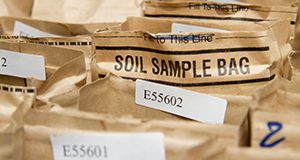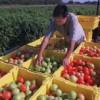This new 6-page publication of the UF/IFAS Department of Soil and Water Sciences is intended to address agronomic and environmental issues related to phosphorus (P) dynamics in Florida agricultural soils and soil test P interpretation and management for agricultural crops. This document aims to provide science-based information to agricultural clientele, including commercial producers, small farmers, Extension agents, crop consultants, landscape professionals, representatives of the fertilizer industry, state and local agencies, students and instructors of high schools and colleges, researchers, and interested Florida citizens. Written by Rao Mylavarapu, Yuncong Li, Maria Silveira, Cheryl Mackowiak, and Mabry McCray.
https://edis.ifas.ufl.edu/ss699
Tag: Phosphorus Control
Parameters for Site-Specific Soil Phosphorus Loss Modeling from Soil Test Data

This four-page fact sheet is part of a series titled Soil Phosphorus Storage Capacity (SPSC) for Phosphorus Risk Assessment and Management. This series is intended for use by those who are interested in management practices and policies that minimize the risk of phosphorus loss from soils. Written by Biswanath Dari, Vimala D. Nair, and Willie G. Harris and published by the Department of Soil and Water Sciences.
http://edis.ifas.ufl.edu/ss656
Factors Affecting Phosphorus Leaching and Groundwater Concentrations for the Plasticulture Vegetable-Production System
 Although Best Management Practices (BMPs) have been developed to reduce the loss of nutrients, like P, to the environment, limited information exists on the main factors that control P loss to Florida groundwater. For example, while it is generally accepted that both irrigation and fertilizer P impact groundwater P, growers often ask if controlling one is more advantageous than the other in their efforts to reduce P leaching. There exists no easy tool to link fertilizer P input and other factors to groundwater P concentration. This 5-page fact sheet uses long-term data (six growing seasons) from a farm in Immokalee, Florida, to explain the effects of soil and agronomic factors, along with seasonal rainfall, on groundwater P. From these factors are derived simple equations to predict groundwater P concentrations. Written by Sanjay Shukla, Gregory S. Hendricks, Thomas A. Obreza, and Willie Harris, and published by the UF Department of Agricultural and Biological Engineering, August 2014.
Although Best Management Practices (BMPs) have been developed to reduce the loss of nutrients, like P, to the environment, limited information exists on the main factors that control P loss to Florida groundwater. For example, while it is generally accepted that both irrigation and fertilizer P impact groundwater P, growers often ask if controlling one is more advantageous than the other in their efforts to reduce P leaching. There exists no easy tool to link fertilizer P input and other factors to groundwater P concentration. This 5-page fact sheet uses long-term data (six growing seasons) from a farm in Immokalee, Florida, to explain the effects of soil and agronomic factors, along with seasonal rainfall, on groundwater P. From these factors are derived simple equations to predict groundwater P concentrations. Written by Sanjay Shukla, Gregory S. Hendricks, Thomas A. Obreza, and Willie Harris, and published by the UF Department of Agricultural and Biological Engineering, August 2014.
http://edis.ifas.ufl.edu/ae507
BMP-Recommended Water and Phosphorus Inputs for Tomato and Watermelon Can Reduce Environmental Losses of Phosphorus and Save Water
 A BMP study was conducted at the research farm of the UF/IFAS Southwest Florida Research and Education Center in Immokalee, FL. The study evaluated two production systems made up of two levels of water and fertilizer inputs for tomato and watermelon production with seepage irrigation. The average water and P fertilizer rates used by growers in south Florida were contrasted with the recommended BMP rates. Applying BMP-recommended water and phosphorus (P) inputs for seepage-irrigated tomato and watermelon in Florida can reduce water use and P leaching to groundwater without adversely impacting fruit yield. However, given the adverse impacts on watermelon yield due to lower than sufficient levels of K, further research is needed to evaluate the fertilizer recommendations for watermelon, especially K2O rates, to ensure economic viability of farms. Our results showed that adoption of BMP-recommended P rates as a BMP did not reduce crop yield and improved water quality. This 4-page fact sheet was written by Sanjay Shukla, Gregory S. Hendricks, Thomas A. Obreza, and Willie G. Harris, and published by the UF Department of Agricultural and Biological Engineering, June 2014.
A BMP study was conducted at the research farm of the UF/IFAS Southwest Florida Research and Education Center in Immokalee, FL. The study evaluated two production systems made up of two levels of water and fertilizer inputs for tomato and watermelon production with seepage irrigation. The average water and P fertilizer rates used by growers in south Florida were contrasted with the recommended BMP rates. Applying BMP-recommended water and phosphorus (P) inputs for seepage-irrigated tomato and watermelon in Florida can reduce water use and P leaching to groundwater without adversely impacting fruit yield. However, given the adverse impacts on watermelon yield due to lower than sufficient levels of K, further research is needed to evaluate the fertilizer recommendations for watermelon, especially K2O rates, to ensure economic viability of farms. Our results showed that adoption of BMP-recommended P rates as a BMP did not reduce crop yield and improved water quality. This 4-page fact sheet was written by Sanjay Shukla, Gregory S. Hendricks, Thomas A. Obreza, and Willie G. Harris, and published by the UF Department of Agricultural and Biological Engineering, June 2014.
http://edis.ifas.ufl.edu/ae504
Comparison of Soil Test Extractants for Available Soil Phosphorus in High pH Sandy Soils of South Florida
 This document addresses the selection of soil nutrient extractants in high pH soils and discusses their relationship to both nutrition and fertilizer management. This document’s objective is to describe the impact of selected soil extractants on nutrient management and their ability to determine soil phosphorus availability. The target audience for this series dealing with citrus nutrition includes Certified Crop Advisers; citrus, vegetable, and sugarcane producers; fertilizer dealers; and other parties interested in crop fertilization practices. This 4-page fact sheet was written by Kelly T. Morgan and Kamal Mahmoud, and published by the UF Department of Soil and Water Science, December 2014.
This document addresses the selection of soil nutrient extractants in high pH soils and discusses their relationship to both nutrition and fertilizer management. This document’s objective is to describe the impact of selected soil extractants on nutrient management and their ability to determine soil phosphorus availability. The target audience for this series dealing with citrus nutrition includes Certified Crop Advisers; citrus, vegetable, and sugarcane producers; fertilizer dealers; and other parties interested in crop fertilization practices. This 4-page fact sheet was written by Kelly T. Morgan and Kamal Mahmoud, and published by the UF Department of Soil and Water Science, December 2014.
http://edis.ifas.ufl.edu/ss613
Cattle Fencing BMP Can Reduce Phosphorus Loads from Florida Ranches
 BMPs are an important tool in helping the state and individual landowners protect and enhance state’s waters. Given the water quality issues facing Lake Okeechobee and other sensitive water bodies, the importance of BMP implementation has increased since their official establishment as part of the FWRA. In order to ensure that BMPs are reducing nutrient loadings, on-farm research is needed to verify BMP effectiveness. A four-year study was conducted to evaluate the effectiveness of the cow/calf stream fencing BMP. The study concluded that the BMP did reduce the amount of P being discharged from the ranch. This BMP should continue to be included in the cow/calf BMP manual, and, hopefully, its widespread implementation will help the state in meeting its TMDLs. This 3-page fact sheet was written by Sanjay Shukla, Wendy D. Graham, Alan Hodges, and James M. Knowles, and published by the UF Department of Agricultural and Biological Engineering, May 2014.
BMPs are an important tool in helping the state and individual landowners protect and enhance state’s waters. Given the water quality issues facing Lake Okeechobee and other sensitive water bodies, the importance of BMP implementation has increased since their official establishment as part of the FWRA. In order to ensure that BMPs are reducing nutrient loadings, on-farm research is needed to verify BMP effectiveness. A four-year study was conducted to evaluate the effectiveness of the cow/calf stream fencing BMP. The study concluded that the BMP did reduce the amount of P being discharged from the ranch. This BMP should continue to be included in the cow/calf BMP manual, and, hopefully, its widespread implementation will help the state in meeting its TMDLs. This 3-page fact sheet was written by Sanjay Shukla, Wendy D. Graham, Alan Hodges, and James M. Knowles, and published by the UF Department of Agricultural and Biological Engineering, May 2014.
http://edis.ifas.ufl.edu/ae501
Effect of Fertilizer Phosphorus Rate of Tomato and Green Bean Yield and Growth in High pH Sandy Soils of South Florida
 This 4-page fact sheet addresses the effect of phosphorus rate on tomato and green bean yield and growth in high pH soils and discusses their relationship to both nutrition and fertilizer management. Written by Kelly T. Morgan and Kamal Mahmoud, and published by the UF Department of Soil and Water Science, December 2013.
This 4-page fact sheet addresses the effect of phosphorus rate on tomato and green bean yield and growth in high pH soils and discusses their relationship to both nutrition and fertilizer management. Written by Kelly T. Morgan and Kamal Mahmoud, and published by the UF Department of Soil and Water Science, December 2013.
http://edis.ifas.ufl.edu/ss611
Effect of Reduced Soil pH with Sulfur on Available Soil Phosphorus in High pH Sandy Soils of South Florida
 This 3-page fact sheet addresses the effect of moderating soil pH by using sulfur amendments in high pH soils and discusses their relationship to both nutrition and fertilizer management. Written by Kelly T. Morgan and Kamal Mahmoud, and published by the UF Department of Soil and Water Science, December 2013.
This 3-page fact sheet addresses the effect of moderating soil pH by using sulfur amendments in high pH soils and discusses their relationship to both nutrition and fertilizer management. Written by Kelly T. Morgan and Kamal Mahmoud, and published by the UF Department of Soil and Water Science, December 2013.
http://edis.ifas.ufl.edu/ss612
Using Reclaimed Water to Irrigate Turfgrass: Lessons Learned from Research with Phosphorus
 Municipal wastes are treated at a wastewater treatment facility to produce biosolids and reclaimed water. Reclaimed water treated by filtration and chlorination is safe to use for designated purposes, such as residential landscape irrigation. Florida began using reclaimed water in 1966, and it is a leading state for using reclaimed water. Approximately 660 million gallons of reclaimed water are used every day in Florida, and the state encourages using reclaimed water as an alternative water source to reduce the pressure on potable water supplies. This 3-page fact sheet summarizes the results of a recent research project and provides research-based information for improving nutrient and water management with reclaimed water irrigation of turfgrass. Written by George Hochmuth, Jinghua Fan, Jason Kruse, and Jerry Sartain, and published by the UF Department of Soil and Water Science, October 2013.
Municipal wastes are treated at a wastewater treatment facility to produce biosolids and reclaimed water. Reclaimed water treated by filtration and chlorination is safe to use for designated purposes, such as residential landscape irrigation. Florida began using reclaimed water in 1966, and it is a leading state for using reclaimed water. Approximately 660 million gallons of reclaimed water are used every day in Florida, and the state encourages using reclaimed water as an alternative water source to reduce the pressure on potable water supplies. This 3-page fact sheet summarizes the results of a recent research project and provides research-based information for improving nutrient and water management with reclaimed water irrigation of turfgrass. Written by George Hochmuth, Jinghua Fan, Jason Kruse, and Jerry Sartain, and published by the UF Department of Soil and Water Science, October 2013.
http://edis.ifas.ufl.edu/ss592
Deep Problems in Shallow Lakes: Why Controlling Phosphorus Inputs May Not Restore Water Quality (SGEF198/SG128)
 Florida’s thousands of lakes are shallower than most people realize, and some unique properties of shallow lakes make them challenging to restore if they have been degraded by nutrients or other pollutants.This 4-page fact sheet examines how water managers track nutrients as they cycle through Florida’s lakes. Written by Karl Havens, and published by the UF Department of Sea Grant, January 2013.
Florida’s thousands of lakes are shallower than most people realize, and some unique properties of shallow lakes make them challenging to restore if they have been degraded by nutrients or other pollutants.This 4-page fact sheet examines how water managers track nutrients as they cycle through Florida’s lakes. Written by Karl Havens, and published by the UF Department of Sea Grant, January 2013.
http://edis.ifas.ufl.edu/sg128
Rethinking the Role of Nitrogen and Phosphorus in the Eutrophication of Aquatic Ecosystems (SGEF190/SG118)
 For many years, environmental agencies have sought to improve the water quality of lakes and estuaries by reducing inputs of phosphorus. New research indicates that we must reduce both phosphorus and nitrogen to reverse eutrophication symptoms. This 3-page fact sheet was written by Karl Havens and Thomas Frazer, and published by the UF Department of Sea Grant, June 2012.
For many years, environmental agencies have sought to improve the water quality of lakes and estuaries by reducing inputs of phosphorus. New research indicates that we must reduce both phosphorus and nitrogen to reverse eutrophication symptoms. This 3-page fact sheet was written by Karl Havens and Thomas Frazer, and published by the UF Department of Sea Grant, June 2012.
http://edis.ifas.ufl.edu/sg118
The Potential for Plants to Remove Phosphorus from the Spodic Horizon (SL359/SS560)
 Under what conditions can plants be used to remove phosphorus from common Florida soils? This 5-page fact sheet shows how calculations for the phosphorus saturation ratio and soil phosphorus storage capacity at various soil depths can be used to determine whether to use phytoremediation as a strategy to remove phosphorus from the soil. Written by D. Chakraborty, V.D. Nair, W.G. Harris, and R.D. Rhue, and published by the UF Department of Soil and Water Science, October 2011.
Under what conditions can plants be used to remove phosphorus from common Florida soils? This 5-page fact sheet shows how calculations for the phosphorus saturation ratio and soil phosphorus storage capacity at various soil depths can be used to determine whether to use phytoremediation as a strategy to remove phosphorus from the soil. Written by D. Chakraborty, V.D. Nair, W.G. Harris, and R.D. Rhue, and published by the UF Department of Soil and Water Science, October 2011.
http://edis.ifas.ufl.edu/ss560
The Long-term Contribution of Phosphorus from Agricultural Lands to Lake Okeechobee (SL357/SS558)
 This 7-page fact sheet uses a new procedure to evaluate the soil from active and abandoned dairies in the Lake Okeechobee watershed to determine their potential to negatively impact water quality through phosphorus release. Written by V.D. Nair, M. Chrysostome, and W.G. Harris, and published by the UF Department of Soil and Water Science, October 2011.
This 7-page fact sheet uses a new procedure to evaluate the soil from active and abandoned dairies in the Lake Okeechobee watershed to determine their potential to negatively impact water quality through phosphorus release. Written by V.D. Nair, M. Chrysostome, and W.G. Harris, and published by the UF Department of Soil and Water Science, October 2011.
http://edis.ifas.ufl.edu/ss558
Phosphorus Sources and Risk Potential: Organic and Inorganic Fertilizers (SL358/SS559)
 One of the factors that determines whether a source of phosphorus will have a negative impact on water quality is solubility. This 3-page fact sheet discusses the significantly different solubility of commonly found phosphorus sources in Florida. Written by V.D. Nair and W.G. Harris, and published by the UF Department of Soil and Water Science, October 2011. (UF/IFAS photo by Milt Putnam)
One of the factors that determines whether a source of phosphorus will have a negative impact on water quality is solubility. This 3-page fact sheet discusses the significantly different solubility of commonly found phosphorus sources in Florida. Written by V.D. Nair and W.G. Harris, and published by the UF Department of Soil and Water Science, October 2011. (UF/IFAS photo by Milt Putnam)
http://edis.ifas.ufl.edu/ss559
Nutrient Mass Budget -The Case of Florida Watermelon Phosphorus Export (SL342/SS547)
Watermelon provides an interesting example of how the phosphorus nutrient balance on the farm has changed over time with changes to production practices and acreage. In this 4-page paper the calculations are described for the export of phosphorus from Florida in the state’s watermelon fruits. Written by George Hochmuth and Jerry Bennett and published by the UF Department of Soil and Water Science, January 2011.
http://edis.ifas.ufl.edu/ss547
SL336/SS541 Understanding Soil Phosphorus Storage Capacity
SL336, a 4-page illustrated fact sheet by Vimala D. Nair, Willie G. Harris, Debolina Chakraborty, and Myrlène Chrysostome, presents an approach to assessing sandy soil phosphorus (P) assimilation capacity prior to reaching a threshold of environmental concern. Includes references. Published by the UF Department of Soil and Water Science, November 2010.
http://edis.ifas.ufl.edu/ss541
SL333/SS539 An Indicator for Risk of Phosphorus Loss from Sandy Soils
SL333, a 3-page illustrated fact sheet by Vimala D. Nair, Willie G. Harris, and Debolina Chakraborty, describes a practical means of determining when a soil has reached a level of P loading that constitutes an environmental risk. Includes references. Published by the UF Department of Soil and Water Sciences, October 2010.
http://edis.ifas.ufl.edu/ss539
SL299/SS512 Are Alum-Based Drinking Water Treatment Residuals Safe for Land Application?
SL-299, an 8-page illustrated fact sheet by Sampson Agyin-Birikorang, George A. O’Connor, and Thomas A. Obreza, explores possible effects of land-applying Al-WTR on the environment, and recommends ways to minimize human impacts. Includes references. Published by the UF Department of Soil and Water Science, July 2009.
http://edis.ifas.ufl.edu/SS512
SL300/SS513 Drinking Water Treatment Residuals to Control Phosphorus in Soils
SL-300, a 7-page illustrated fact sheet by Sampson Agyin-Birikorang, George A. O’Connor, and Thomas A. Obreza, describes the phosphorous problem in Florida, and the use of this byporoduct of municipal drinking water purification as a soil amendment to reduce nonpoint source polution by phosphorous. Includes references. Published by the UF Department of Soil and Water Sciences, July 2009.
http://edis.ifas.ufl.edu/SS513
SL275/SS490 Impact of Phosphorus on Water Quality
SL-275, a 4-page fact sheet by Rao Mylavarapu, highlights the role of phosphorus, interactions with the environment, and its potential impact on water quality. It is intended to serve audiences such as high school students, farmers, and the general public seeking information on the causes and mechanisms of potential phosphorus effects on water quality. Includes references. Published by the UF Department of Soil and Water Sciences, December 2008.
http://edis.ifas.ufl.edu/SS490
